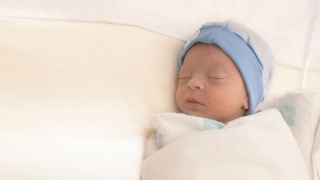Do Vital Sign Baby Monitors Work? Research Says, Beware
Published on
Health Tip of the WeekPublished on
Health Tip of the Week Typically, baby monitors let parents hear if a baby is crying from another room or see what they’re doing in their crib. But today, a handful of monitors measure vital signs, claiming to provide parents with insights into their baby’s health.
Typically, baby monitors let parents hear if a baby is crying from another room or see what they’re doing in their crib. But today, a handful of monitors measure vital signs, claiming to provide parents with insights into their baby’s health.
These high-tech baby monitors have wireless electronics integrated into socks, leg bands, buttons, onesies or diaper clips. These sensors send data to parents’ smartphones using Bluetooth technology. They have the capability to measure a baby’s respiration, pulse rate and blood-oxygen levels. If something appears to be outside the normal ranges, an alert is sent to parents’ smartphones.
This sounds like a good thing, right? Not so fast. A recent study led by Chris Bonafide, MD, MSCE, a pediatrician and safety expert at Children’s Hospital of Philadelphia (CHOP), found serious concerns with the accuracy of such monitors. (Read more about the study findings: Two Consumer Baby Monitors Show Worrisome Results in Measuring Vital Signs.)
Dr. Bonafide decided to study these monitors in 2013, when an infant was admitted to CHOP after a monitor the parents were using alarmed and doctors couldn’t find any obvious issues (a thorough evaluation found that the child was fine). The American Academy of Pediatrics (AAP) already cautions against such monitors, claiming they are not shown to have any role in preventing sudden infant death syndrome (SIDS) or related issues — and they haven’t been cleared by the Food & Drug Administration (FDA), either.
Pulse oximetry baby monitors are supposed to estimate the amount of oxygen in a child’s blood. The trouble, says Bonafide, is this measure is not something a parent can confirm on their own. As a result, if a parent sees numbers that are out of range, the only way to verify them is to seek medical attention, which often means bringing their child to the emergency room (ER).
Last year, Dr. Bonafide and his fellow researchers wrote an opinion piece in the Journal of the American Medical Association raising concerns about consumer use of physiological baby monitors being broadly marketed to parents. As a follow-up to that piece, Dr. Bonafide and his team recently completed a study to find out if these devices are accurate or not. The study found that they often trigger unwarranted alarms that land families in the ER unnecessarily.
Dr. Bonafide shared a few key points parents should understand about pulse oximetry baby monitors:
“These monitors may not detect all of the things they claim to detect and may generate false alarms,” says Bonafide. “If you choose to use one of these monitors, I would urge you to have an up-front, open conversation with your pediatrician about their limits and collaborate on a plan about what to do when alarms go off in the middle of the night.”
Contributed by: Christopher P. Bonafide, MD, MSCE
Categories: Health Tip of the Week